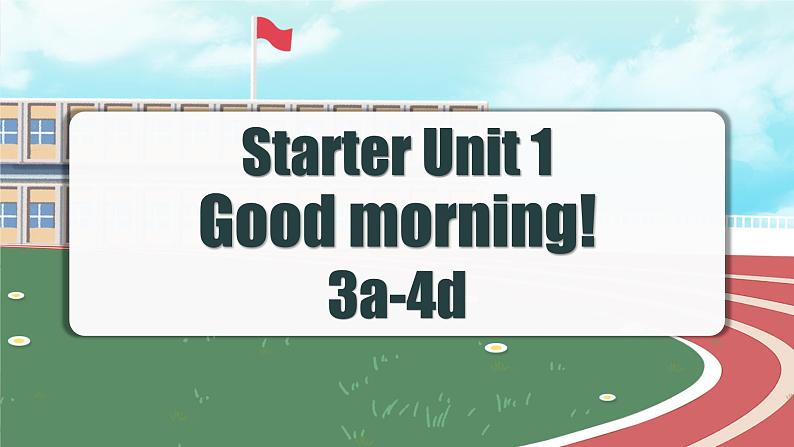







还剩29页未读,
继续阅读
Starter Unit1(3a-4d)课件
展开
这是一份Starter Unit1(3a-4d)课件,共37页。
Starter Unit 1Good morning!3a-4d01Lead-inGreet the letters you see.Let’s review Let’s readLet’s read them together.Free talkTry to greet your partner.Good morning,…!Good morning, …!Hello,…!Hi, …!02Pre-listeningLet’s thinkGood afternoon, Eric!Good afternoon, Frank!Look at the pictures and complete the blanks.after + noon = afternoon在…之后中午下午Let’s thinkGood morning, Helen!Good morning, Dale!Look at the pictures and complete the blanks.早晨见面的人们通常会用Good morning!来进行互相问候,在非正式场合及日常口语中,熟人和朋友之间常用Morning!进行问候。Let’s thinkGood evening, Bob!Good evening, Alice!Look at the pictures and complete the blanks.晚上见面的人们通常会用Good evening!来进行互相问候,表达“晚上好”的含义。Good night! 是晚上分别前或就寝前的道别用语,表达“晚安;再见”的含义。Let’s learnWhen you meet your friends in the morning, inthe afternoon or in the evening, what can you say?Good morning!Good afternoon!Good evening!03While-listeningListen and number the pictures [1-3].Let’s listen3aGood afternoon, Eric!Good afternoon, Frank!Good morning, Helen!Good morning, Dale!Good evening, Bob!Good evening, Alice!132123Listen and repeat.Let’s listen1bDale: Good morning, Helen!Helen: Good morning, Dale!Frank: Good afternoon, Eric!Eric: Good afternoon, Frank!Alice: Good evening, Bob!Bob: Good evening, Alice!Let’s practicePractice the conversations in 3a with your partner.3bGood morning, Helen!Good morning, Dale!Good afternoon, Eric!Good afternoon, Frank!Good evening, Bob!Good evening, Alice!Let’s answerWhen is it?2. Where are they?3. Who are they?It’s in the afternoon.They are in a library.They are Cindy and Dale.Good afternoon, Dale!Hi, Cindy!How are you?I’m fine, thanks.How are you?I’m OK.Look at the picture and answer the questions.Let’s learnGood afternoon, Dale!Hi, Cindy!How are you?I’m fine, thanks.How are you?I’m OK.How are you?是熟人见面时所用的问候语,用来询问对方的状况。其答语为“Fine/I’m fine/I’m OK, thanks.”,表示“我很好,谢谢。”Listen to the conversation. Then practice it with your partner.Let’s listen3cCindy: Good afternoon, Dale!Dale: Hi, Cindy! How are you?Cindy: I’m fine, thanks. How are you?Dale: I’m OK.Choose an English name for yourself. Then greet each other.Let’s choose3dGood afternoon !Good evening !Good morning !How are you?Hi / Hello !Let’s writeCan you put them in alphabetical order?(按字母顺序排列)Write the names of the children on page S1. 3dLet’s listenListen and repeat.4b [ei] [i:][æ][e]Let’s learnLook and think4b [ei] [i:][æ][e]04Post-listeningLet’s readRead the letters and words in column 1. Try to read the new words in column 2. 4c [ei] [æ][i:][e]Let’s readGood morning!Good morning!How are you?I'm fine, thanks.How are you?I'm OK.默读歌词,找出歌词中的问候语和答语。Good afternoon!Good afternoon!How are you?I'm fine, thanks.How are you?I'm OK.Good evening!Good evening!How are you?I'm fine, thanks.How are you?I'm OK.问候语答语问候语答语答语问候语第1,3,6行是某人的问候及回答,第2,4,5行是对方的答语或提问。05Language PointsLanguage points1. How are you? (教材PS3 3c)how意为“怎样”,you意为“你、你们”,How are you?是熟人间见面时常用的问候语,用来询问对方身体状况。答语有“I’m fine, thanks./I’m OK, thank you.” 等。还可以反问对方“How are you?”或“And you?”。—How are you? 你好吗?—I’m OK, thank you. And you? 我很好,谢谢。你呢?PointHow are you? 你好吗?【拓展】“How do you do?(你好。) ”是初次见面的问候语,对方也用同样的话回答。Language points2. I’m fine./I’m OK. (教材PS3 3c)I’m是I am的缩写形式,fine作形容词,在此意为“健康的”,也可表示“美好的”,I’m fine.常用来对“How are you?”做出应答。PointI’m fine. 我很好。I’m OK.也常用来对“How are you?”做出应答。OK两个字母要大写,也可写作okay,在此处指身体状况好,相当于fine。PointI’m OK. 我很好。Language points3. I’m fine, thanks. (教材PS3 3c)thanks.意为“谢谢”,相当于“thank you.”,用来对他人的关心、帮助、夸奖、赞美、祝福和问候表示感谢。—Your sweater is nice. 你的毛衣很漂亮。—Thanks. 谢谢。am, is, are是be动词的三种形式,意为“是”,am与第一人称单数主语 I 连用;is与第三人称单数主语 he/she/it/Lily/… 连用;are与第二人称主语you及复数主语we/they/… 连用。I am a student. 我是一名学生。Are you a teacher? 你是一名老师吗?He is ten. 他十岁。Language points开音节与闭音节1) 开音节分绝对开音节和相对开音节两种。绝对开音节:以单个元音字母结尾的重读音节,如:hi, no等。相对开音节:单个元音字母后加单个辅音字母(r除外),再加上一个不发音的字母e 构成的重读音节, 如:name, bike等。2) 闭音节:以一个或几个辅音字母(r, w, y除外)结尾而中间只有一个元音字母的音节, 如:pen, map等。06Exercises 一、将字母A-H按发音分类/eɪ/ _________________________/i:/ _________________________ABCDE/e/ _________________________FGHExerciseExercise二、从方框中找出下列各句对应的应答语。( ) 1. Good morning. ( ) 2. How are you? ( ) 3. Hello! ( ) 4. Good evening. A. Good evening. B. I'm fine, thanks.C. Hi!D. Good morning. DBCA07Summary Summary Good morning!Key wordsPronunciationafternoon, evening, how, are, you, I, am, fine, thanks, OK A: 开音节 /eɪ/ 闭音节 /æ/—Good afternoon/evening, Eric! —How are you?—Good afternoon/evening, Bob!SentencesE: 开音节 /i:/ 闭音节 /e/—I'm fine, thanks./I'm OK. A life without friend is like a life without sun!Try to make friends in your new term!08Homework 按字母表顺序默写字母A到H的大写与小写。2. 与你朋友组织小对话表演,用英语进行问候。Thanks for listening !
Starter Unit 1Good morning!3a-4d01Lead-inGreet the letters you see.Let’s review Let’s readLet’s read them together.Free talkTry to greet your partner.Good morning,…!Good morning, …!Hello,…!Hi, …!02Pre-listeningLet’s thinkGood afternoon, Eric!Good afternoon, Frank!Look at the pictures and complete the blanks.after + noon = afternoon在…之后中午下午Let’s thinkGood morning, Helen!Good morning, Dale!Look at the pictures and complete the blanks.早晨见面的人们通常会用Good morning!来进行互相问候,在非正式场合及日常口语中,熟人和朋友之间常用Morning!进行问候。Let’s thinkGood evening, Bob!Good evening, Alice!Look at the pictures and complete the blanks.晚上见面的人们通常会用Good evening!来进行互相问候,表达“晚上好”的含义。Good night! 是晚上分别前或就寝前的道别用语,表达“晚安;再见”的含义。Let’s learnWhen you meet your friends in the morning, inthe afternoon or in the evening, what can you say?Good morning!Good afternoon!Good evening!03While-listeningListen and number the pictures [1-3].Let’s listen3aGood afternoon, Eric!Good afternoon, Frank!Good morning, Helen!Good morning, Dale!Good evening, Bob!Good evening, Alice!132123Listen and repeat.Let’s listen1bDale: Good morning, Helen!Helen: Good morning, Dale!Frank: Good afternoon, Eric!Eric: Good afternoon, Frank!Alice: Good evening, Bob!Bob: Good evening, Alice!Let’s practicePractice the conversations in 3a with your partner.3bGood morning, Helen!Good morning, Dale!Good afternoon, Eric!Good afternoon, Frank!Good evening, Bob!Good evening, Alice!Let’s answerWhen is it?2. Where are they?3. Who are they?It’s in the afternoon.They are in a library.They are Cindy and Dale.Good afternoon, Dale!Hi, Cindy!How are you?I’m fine, thanks.How are you?I’m OK.Look at the picture and answer the questions.Let’s learnGood afternoon, Dale!Hi, Cindy!How are you?I’m fine, thanks.How are you?I’m OK.How are you?是熟人见面时所用的问候语,用来询问对方的状况。其答语为“Fine/I’m fine/I’m OK, thanks.”,表示“我很好,谢谢。”Listen to the conversation. Then practice it with your partner.Let’s listen3cCindy: Good afternoon, Dale!Dale: Hi, Cindy! How are you?Cindy: I’m fine, thanks. How are you?Dale: I’m OK.Choose an English name for yourself. Then greet each other.Let’s choose3dGood afternoon !Good evening !Good morning !How are you?Hi / Hello !Let’s writeCan you put them in alphabetical order?(按字母顺序排列)Write the names of the children on page S1. 3dLet’s listenListen and repeat.4b [ei] [i:][æ][e]Let’s learnLook and think4b [ei] [i:][æ][e]04Post-listeningLet’s readRead the letters and words in column 1. Try to read the new words in column 2. 4c [ei] [æ][i:][e]Let’s readGood morning!Good morning!How are you?I'm fine, thanks.How are you?I'm OK.默读歌词,找出歌词中的问候语和答语。Good afternoon!Good afternoon!How are you?I'm fine, thanks.How are you?I'm OK.Good evening!Good evening!How are you?I'm fine, thanks.How are you?I'm OK.问候语答语问候语答语答语问候语第1,3,6行是某人的问候及回答,第2,4,5行是对方的答语或提问。05Language PointsLanguage points1. How are you? (教材PS3 3c)how意为“怎样”,you意为“你、你们”,How are you?是熟人间见面时常用的问候语,用来询问对方身体状况。答语有“I’m fine, thanks./I’m OK, thank you.” 等。还可以反问对方“How are you?”或“And you?”。—How are you? 你好吗?—I’m OK, thank you. And you? 我很好,谢谢。你呢?PointHow are you? 你好吗?【拓展】“How do you do?(你好。) ”是初次见面的问候语,对方也用同样的话回答。Language points2. I’m fine./I’m OK. (教材PS3 3c)I’m是I am的缩写形式,fine作形容词,在此意为“健康的”,也可表示“美好的”,I’m fine.常用来对“How are you?”做出应答。PointI’m fine. 我很好。I’m OK.也常用来对“How are you?”做出应答。OK两个字母要大写,也可写作okay,在此处指身体状况好,相当于fine。PointI’m OK. 我很好。Language points3. I’m fine, thanks. (教材PS3 3c)thanks.意为“谢谢”,相当于“thank you.”,用来对他人的关心、帮助、夸奖、赞美、祝福和问候表示感谢。—Your sweater is nice. 你的毛衣很漂亮。—Thanks. 谢谢。am, is, are是be动词的三种形式,意为“是”,am与第一人称单数主语 I 连用;is与第三人称单数主语 he/she/it/Lily/… 连用;are与第二人称主语you及复数主语we/they/… 连用。I am a student. 我是一名学生。Are you a teacher? 你是一名老师吗?He is ten. 他十岁。Language points开音节与闭音节1) 开音节分绝对开音节和相对开音节两种。绝对开音节:以单个元音字母结尾的重读音节,如:hi, no等。相对开音节:单个元音字母后加单个辅音字母(r除外),再加上一个不发音的字母e 构成的重读音节, 如:name, bike等。2) 闭音节:以一个或几个辅音字母(r, w, y除外)结尾而中间只有一个元音字母的音节, 如:pen, map等。06Exercises 一、将字母A-H按发音分类/eɪ/ _________________________/i:/ _________________________ABCDE/e/ _________________________FGHExerciseExercise二、从方框中找出下列各句对应的应答语。( ) 1. Good morning. ( ) 2. How are you? ( ) 3. Hello! ( ) 4. Good evening. A. Good evening. B. I'm fine, thanks.C. Hi!D. Good morning. DBCA07Summary Summary Good morning!Key wordsPronunciationafternoon, evening, how, are, you, I, am, fine, thanks, OK A: 开音节 /eɪ/ 闭音节 /æ/—Good afternoon/evening, Eric! —How are you?—Good afternoon/evening, Bob!SentencesE: 开音节 /i:/ 闭音节 /e/—I'm fine, thanks./I'm OK. A life without friend is like a life without sun!Try to make friends in your new term!08Homework 按字母表顺序默写字母A到H的大写与小写。2. 与你朋友组织小对话表演,用英语进行问候。Thanks for listening !

相关资料
更多









